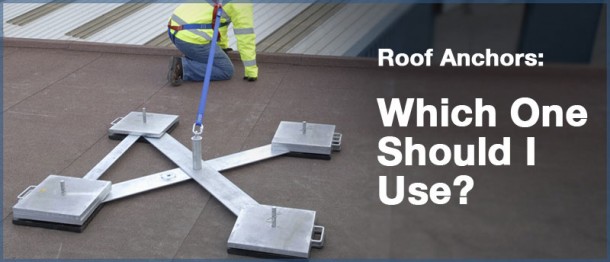Roof Anchors: Which One Should I Use?

Years ago, there was little choice of which type of fall protection you could use because there just wasn’t much variety available. More recently, though, manufacturers have made great strides in occupational safety technology. In fact, for almost every situation there is a solution. Roof anchors are a perfect example. Obviously, one roof can be very different from the next, so an anchor point used on one can be completely useless on another. The fact that temporary and/or mobile anchor points exist is great, but it is more important that in addition to using them, you ensure that you are using the correct one.
There are a variety of different mobile anchor points. Some would work well on roofs and some would not. Let’s take a look at three types of roofs and the temporarily installed anchors which could be used on each.
Commercial Roofs
Flat. Featureless. Sometimes without even the slightest of parapets. Commercial roofs are always a challenge. Part of this challenge is that maintenance workers may frequently visit a roof for short, quick projects, disregarding fall protection altogether. Often, the concern is that the job will be finished in much less time than it takes to worry about fall protection. Maybe so, but that doesn’t exclude the employer from their duty to protect their workers. How, then, can this be achieved?
Well, if the employer is not going to install a permanent rail system, they need to begin thinking about permanent or temporarily installed roof anchors. Some roof anchors are designed to be permanently mounted to steel, wood, or concrete and left in place. Any employee accessing the roof can immediately proceed to the anchor point and connect their harness to it. For buildings you own, this is a very effective solution that allows the user to quickly protect themselves. It does require roof penetration, so it is important to prevent water intrusion after installation, but once in place there is little to think about. Anchors like these come in varying heights and can also be used in groups to create horizontal lifelines. For roofs with multiple areas that need to be accessed, the lifeline option can be very helpful.
Other options for commercial roofs include parapet clamps (for when a parapet is available but not high enough to act as fall protection itself) or a non-penetrating anchor points. The issue for these is that while they offer the option of protection without roof penetration, they are often not left in place, so there is much more planning and work involved than with a permanently mounted anchor.
Residential Roofs
Residential roofs have long been a challenge. Either the technology wasn’t available or was so costly it would have adversely affected the final price of homes. This was such an issue that OSHA policy had been to not enforce the 29 CFR 1926 Subpart M Fall Protection regulations when it came to residential construction. This is no longer the case. OSHA is now set to hold residential contractors to the same standard as commercial contractors. The old arguments no longer hold much water because fall protection equipment for residential construction is widely available and is relatively inexpensive. Anchors can range from as low as $14 or, for additional features, can run up to a couple of hundred . Most are designed to be attached directly to the wood frame , to the wooden roof itself, or for use on wood or tile roofs .
These are inexpensive and quick to install - a small price to pay for the well-being of your workers.
Standing Seam Roofs
In the event you find yourself working on a standing seam roof, the previously discussed anchors may or may not help you, yet products exist that were specifically designed for fall protection on standing seam roofs . This exemplifies what was stated above: for almost every situation there is a solution. Standing seam roofs are a very specific type of roof, yet there are clamp-style anchors and other two-way standing seam anchors available that were designed for them. If you know your company will be working on these roofs, then having these anchors in your arsenal will be invaluable.
Not too long ago, finding protection for specific situations like this would have been impossible. The key to all this is doing your research and planning ahead and knowing what type of roofs you will be working on. There is nothing worse than a worker climbing to a roof only to find out the type of fall protection he or she had planned for is not going to work for their current situation. Too often, this leads to no fall protection being used at all.
Roof anchors are as diverse as there are types of roofs to work on, maybe even more so. If you are working on a roof, you must be protected and, with the help of technology, you can be. Don’t accept risks that put your life or the lives of your workers in danger.


